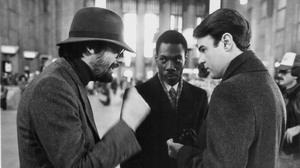John Landis (1978-1983)

In the late 1970s, John Landis experienced an extraordinary rise to prominence, becoming one of Hollywood’s most bankable directors. Known for his sharp comedic sensibilities and penchant for blending humor with music and genre conventions, Landis delivered a string of films that defined the era and continue to influence popular culture. His ability to balance chaos and control—both in his storytelling and his filmmaking style—made him a standout among his contemporaries. Yet, Landis’s success during this period wasn’t without controversy. His boundary-pushing ambition sometimes veered into recklessness; a trait that culminated in a tragic accident that tarnished his reputation. Despite this, his contributions to comedy and genre filmmaking during these years remain significant, with several of his films achieving cult status.
Animal House (1978) Animal House is the film that launched Landis into the Hollywood mainstream and established the blueprint for raunchy, irreverent comedies. Set at the fictional Faber College, the story of the chaotic Delta fraternity’s battle against the uptight administration became an instant cultural phenomenon. Landis’s direction harnesses the anarchic energy of the ensemble cast, led by John Belushi’s iconic performance as Bluto. The film’s humor—ranging from slapstick to biting satire—reflected a rebellion against authority that resonated deeply. The now-legendary food fight and “Toga Party” scenes are perfect examples of Landis’s ability to orchestrate comedic chaos while maintaining narrative momentum. Initially dismissed as lowbrow and juvenile, Animal House redefined the college comedy genre, spawning countless imitators and cementing Landis’s reputation as a director who understood the pulse of his audience. Its enduring influence can still be felt in contemporary comedies.
The Blues Brothers (1980) The Blues Brothers is perhaps Landis’s most ambitious and unconventional project, blending musical extravagance, car-chase mayhem, and deadpan comedy into a singularly bizarre experience. Reuniting Dan Aykroyd and John Belushi as Jake and Elwood Blues, the film follows their chaotic journey to “get the band back together” in order to save their childhood orphanage. Landis’s direction transforms the film into a love letter to blues and soul music, featuring show-stopping performances from legends like Aretha Franklin, Ray Charles, and James Brown. The musical numbers are exuberant and kinetic, seamlessly integrated into the absurdist narrative. Meanwhile, the film’s relentless car chases—most notably the destruction of dozens of police vehicles in downtown Chicago—showcase Landis’s flair for staging large-scale set pieces. Recognized as a cult classic, The Blues Brothers is a testament to Landis’s willingness to take creative risks, blending genres in ways few directors dared to attempt.
An American Werewolf in London (1981) With An American Werewolf in London, Landis ventured into horror, delivering one of the most innovative genre films of the 1980s. The story of an American tourist (David Naughton) who transforms into a werewolf after being bitten during a trip to the English countryside is equal parts terrifying and hilarious, striking a delicate tonal balance that few filmmakers could achieve. Landis’s script injects the film with his trademark humor, but it’s his collaboration with makeup artist Rick Baker that truly sets it apart. The now-legendary transformation scene, achieved through groundbreaking practical effects, remains a high-water mark for the genre. The film also features moments of shocking violence, juxtaposed with darkly comedic elements, creating an experience that is as unsettling as it is entertaining. Landis’s ability to seamlessly blend scares and laughs established a touchstone for horror-comedy hybrids and solidified his reputation as a versatile filmmaker capable of transcending genre boundaries.
Trading Places (1983) Landis returned to pure comedy with Trading Places, a sharp satire of class and privilege that paired Dan Aykroyd and Eddie Murphy in a modern reimagining of The Prince and the Pauper. The film follows a wealthy executive (Aykroyd) and a street hustler (Murphy) who are unwittingly manipulated by two ruthless businessmen in a cruel social experiment. Landis’s direction keeps the film’s comedic elements sharp while allowing space for its commentary on greed, race, and power to resonate. Murphy’s breakout performance showcases his magnetic screen presence, while Aykroyd delivers a pitch-perfect turn as the hapless victim of corporate scheming. The supporting cast, including Jamie Lee Curtis and Ralph Bellamy, adds depth to the film’s satirical edge. Trading Places cemented Landis’s status as a master of ensemble comedy, its social critique remaining relevant, and proving that Landis could deliver laughs while addressing deeper societal issues.
Twilight Zone: The Movie (1983) Twilight Zone: The Movie marked a dark turning point in Landis’s career. Contributing to this reimagining of Rod Serling’s anthology television series alongside Steven Spielberg, Joe Dante, and George Miller, Landis directed the opening segment. However, the production was overshadowed by a horrific on-set accident that claimed the lives of actor Vic Morrow and two child actors during a helicopter stunt. The incident sparked a high-profile legal battle and significantly damaged Landis’s reputation, raising questions about safety protocols and directorial responsibility. Twilight Zone: The Movie serves as a cautionary tale about the risks of filmmaking ambition, and marked the end of Landis’ meteoric rise, casting a dark shadow over his subsequent career.
Overall Appraisal Between 1978 and 1983, John Landis emerged as one of Hollywood’s most distinctive directors, delivering a string of films that defined comedy and genre filmmaking for a generation. His ability to blend humor with music (The Blues Brothers), horror (An American Werewolf in London), and social commentary (Trading Places) showcased his range and creativity. Few directors of his era had such an innate understanding of audience tastes, which allowed him to create films that were not only commercially successful but also culturally significant. While his earlier successes remain undeniably influential, the Twilight Zone tragedy cast a long shadow over his career and legacy. In the end, films like Animal House, The Blues Brothers and Trading Places continue to entertain and inspire, while An American Werewolf in London stands as a landmark in horror cinema. These films capture the spirit of an era, combining irreverence, innovation, and a touch of chaos in ways that few filmmakers could replicate.
